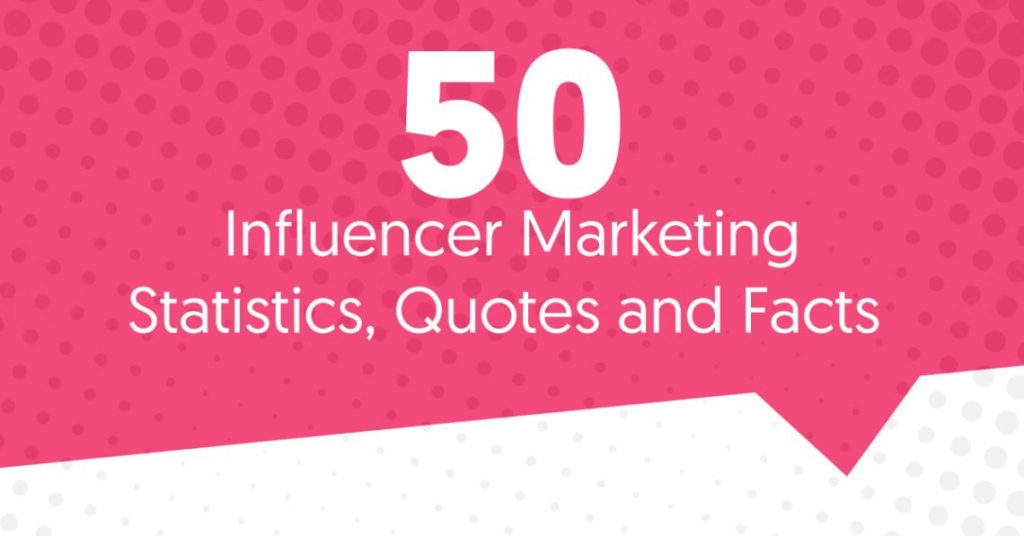50 Influencer Marketing Statistics, Quotes and Facts
According to Wikipedia, “Influencer marketing (also influence marketing) is a form of marketing in which focus is placed on specific key individuals (or types of individual) rather than the target market as a whole.” Over the last five years, it has grown from obscurity to a form of marketing where even the biggest brands understand its value. There have been numerous studies analyzing influencer marketing’s effects, and experts sharing their wisdom on the topic. Here are 50 interesting facts, quotes, and statistics related to influencer marketing.
-
Businesses are making $6.50 for every $1 spent on influencer marketing
A 2015 survey by Tomoson emphasizes how influencer marketing can be highly lucrative for those brands who engage in it. The top 13% of businesses make $20 or more. Most businesses get solid results from influencer marketing, with just the bottom 18% failing to generate any revenue.
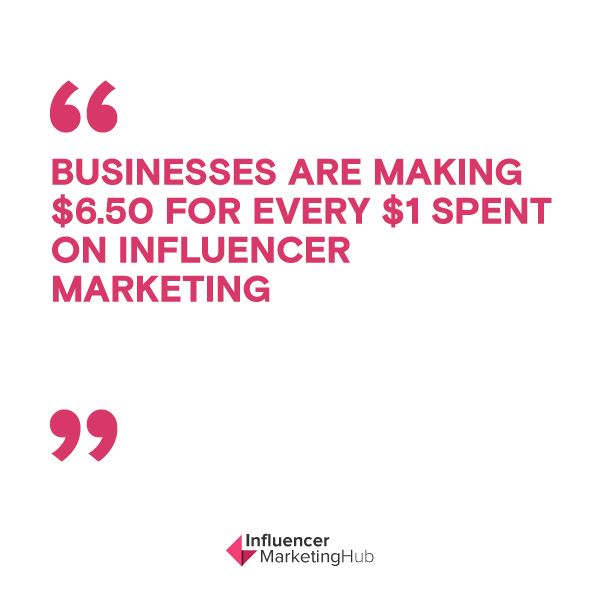
-
59% of marketers intend to increase their influencer marketing budget in the next year.
This statistic comes from the same Tomoson survey. Marketers clearly see how lucrative influencer marketing can be to a brand – when it’s done correctly.
-
Successful YouTubers can earn millions from their videos
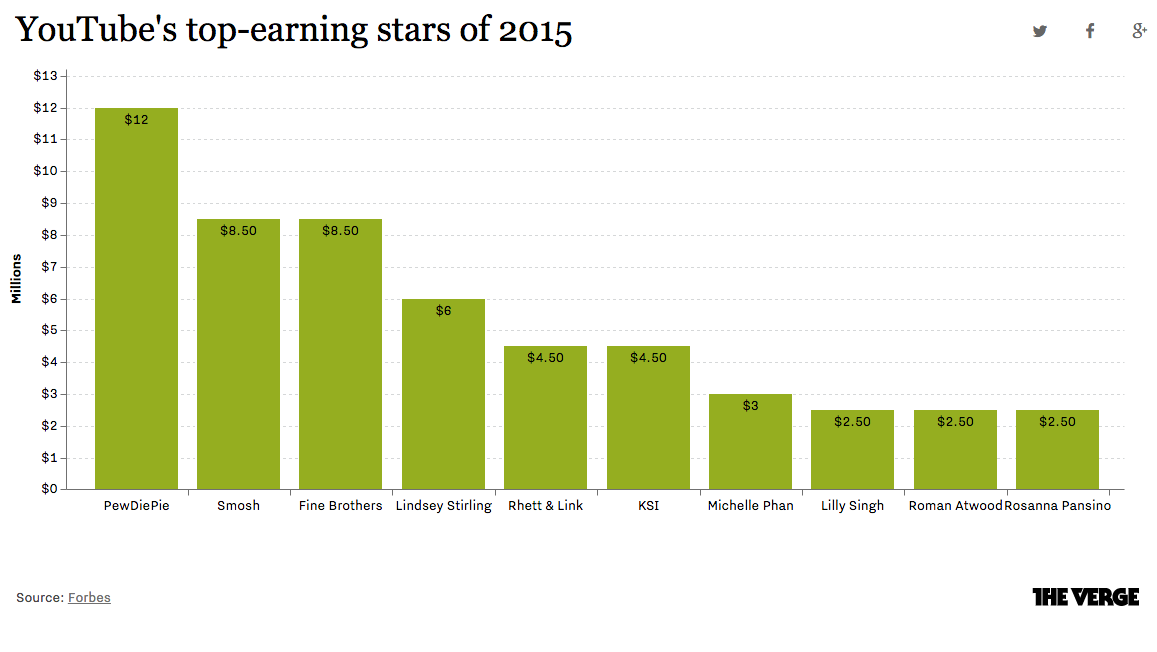
Source: http://www.forbes.com/sites/maddieberg/2015/10/14/the-worlds-highest-paid-youtube-stars-2015/
The most successful, and influential, channel on YouTube is that of PewDiePie. MoneyNation estimates that in December 2016 he had a Net Worth of $90 million, predominantly earned from his YouTube channel.
-
Quote: “…when working with influencers, brands have to let go and allow influencers control of the narrative to preserve the authenticity of what is being communicated.”
Priyanka Dayal, content marketing manager at Centaur Media PLC, observes how influencer marketing is different from traditional marketing, where brands have traditionally had full control over their marketing. She emphasizes the fact that today’s consumer can tell the difference between an advert, a personal recommendation, and an advert masked under a personal recommendation. “For influencer marketing to sustain, authenticity and credibility is key.”
-
Department store chains now partner with fashion bloggers to promote new initiatives and publicize their stores
Quite a few of the big name department stores recognize the influence of fashion bloggers in promoting their stores and products. These include Bergdorf Goodman, Harrods and Bloomingdale’s. These partnerships allow the fashion stores to connect with consumers on a more intimate level than traditional celebrity endorsement.
-
67.6% of marketers consider finding relevant influencers their largest influencer marketing challenge
Tapinfluence and Altimeter joined forces to produce a study on the state of influencer marketing. Of the marketers they surveyed, 67.6% acknowledged difficulty in finding relevant influencers.

-
69.4% of influencers chose to be influencers so they could earn revenue
The same Tapinfluence / Altimeter study interviewed influencers. When asked to provide reasons for their participation in this form of marketing, nearly 70% admitted that their main inspiration was to earn some money. 57.5% of them also claimed that they engaged as influencers to make an impact or effect change.
-
Quote: “Engagement is the new impressions. It matters as much, if not more, than someone’s reach.”
Kristy Sammis made this comment in a March 2016 episode of the podcast, Half Hour Intern. She made another very salient point: “We’re savvier than ever, and we know B.S. when we smell it…As soon as you try to interrupt their (the influencer’s) voice and shove your corporate words into their mouths, there is no purpose in working with them.”
-
The aim of Influencer Marketing is to identify the influencers in your niche and make them work for you by promoting your brand.
A firm’s emphasis needs to be on reaching to the people from whom they can get maximum conversions rather than targeting the market as a whole.

-
54 percent of influencers say they will work with brands who respect them as they would any other publisher
Crowdtap interviewed more than 50 content creators, and it is clear that these influencers expect respect from brands who work with them. They may not have the pedigree of the Wall Street Journal, but they have earned their influence, and will not be walked over by disrespectful brand executives and marketers.
-
Content creators say their most important method for vetting brand partnerships is by determining which opportunities are most relevant for their audiences
This is from the same Crowdtap survey as above. Brands must remember that while influencers like to be able to earn revenue, they will not do so at the expense of their audience.
-
67% of marketing and communications professionals engage with influencers for content promotion
A May 2015 study by Schlesinger Associates for Augure showed that content promotion was the main reason that marketing and communications professional engaged with influencers – ahead of product launch, content creation, event management, corporate communications, SEO, and crisis management.
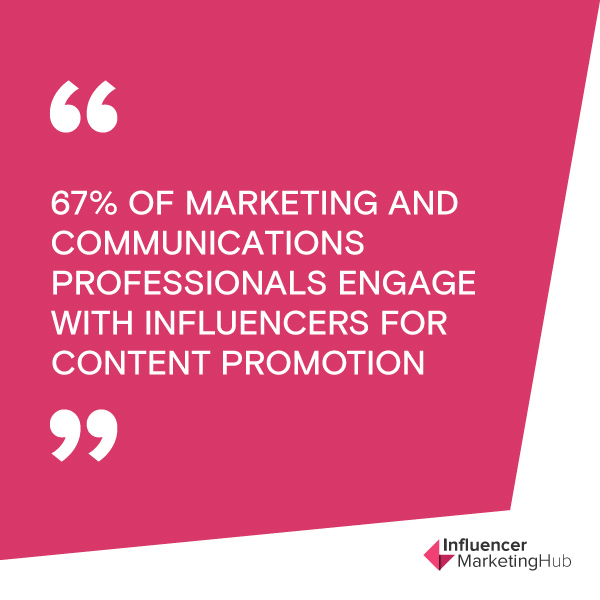
-
75% of marketing and communications professionals say verified web traffic of an influencer is the most important criteria when selecting an influencer
This is an interesting statistic from the same Schlesinger Associates for Augure survey as above. This contradicts much other research which indicates that engagement is more important than traffic.
-
The increase in influencer marketing 2014-2016 mirrors the decrease in print advertising

Source: google.com/trends
Google Trends shows a comparable increase in influencer marketing at the same time as print advertising has been falling.
-
There are three types of influencers: Celebrity Influencers, Macro Influencers, and Micro Influencers.
Influencer marketing does not focus on celebrity endorsement. Micro influencers perform the bulk of successful influencer marketing (at least 90% of it). They are normal people who have built up a solid social media following.
-
59% of micro-influencers believe Instagram to be the most effective social media platform for engaging their target audience
This somewhat surprising result from a Bloglovin’ survey on How Micro-Influencers Really Want to Work With Brands emphasizes Instagram’s visual appeal when it comes to getting your message across.
-
77% of fashion micro-influencers prefer Instagram

Instagram engagement rate. Source Locowise
The influencers preference for Instagram grows even greater when the influencer works in a highly visual niche such as fashion. In comparison, only 31% of entertainment/pop culture micro-influencers prefer Instagram – a less visual niche.
-
53% of micro-influencers have never paid to promote a post.
This is another thought-provoking result from the Bloglovin’ survey. The majority of influencers have managed to achieve their influential status without paying for promotion. Less than 10% have paid for Instagram native ads, despite their love of this platform. Of course, brands can gain extra reach should they choose to pay for boosted/promoted posts.
-
Quote: “As long as I get to do my thing and someone wants to write me a check for it, I’m all about it.” – Mike Perry, Broad City Designer
If you, as a brand, have done your homework, you should have selected the most suitable person as your influencer. Remember that they have built up their own brand. Therefore you need to ensure that your messages to their audience are authentic to that audience. You need to encourage your influencers to share your brand story in their voice.
-
Nearly 40% of Twitter users say they’ve made a purchase as a direct result of a Tweet from an influencer
Twitter partnered with @Annalect to study people’s receptivity to influencers on Twitter. It is clear that Twitter influencers have built up a sufficiently high level of trust for people to be confident enough to spend money on their recommendations.
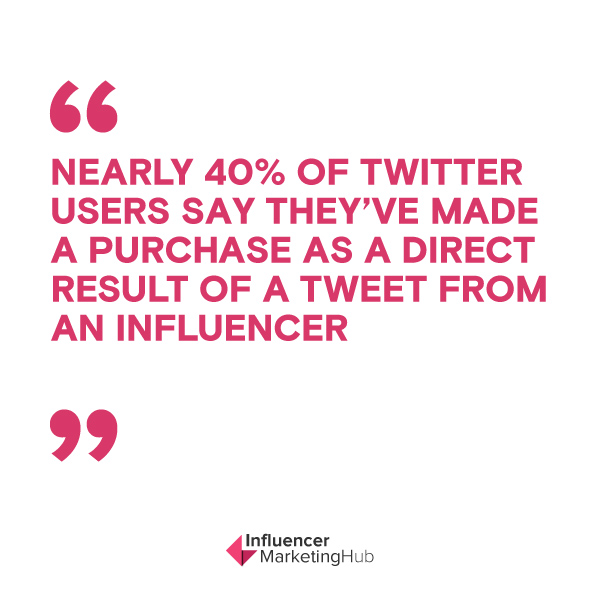
-
Participants aged 13-24 were twice as likely to evaluate an influencer by their social presence and follower count as older audiences
This was another result from the Twitter survey. There is a clear distinction in the way that different age groups look at influence in social media. Older generations tend to follow traditional celebrities. Millennials and Generation Z are more likely to take an interest in social media sensations, such as PewDiePie.
-
70% of teenage YouTube subscribers say they relate to YouTube creators more than traditional celebrities
This statistic, provided by Google, again emphasizes the differences between the generations. Television has a far smaller impact on Generation Z that is had on previous generations. Hence they have far less of interest in traditional celebrities. The current generation has grown up with the internet, and the internet is where they find their own celebrities.
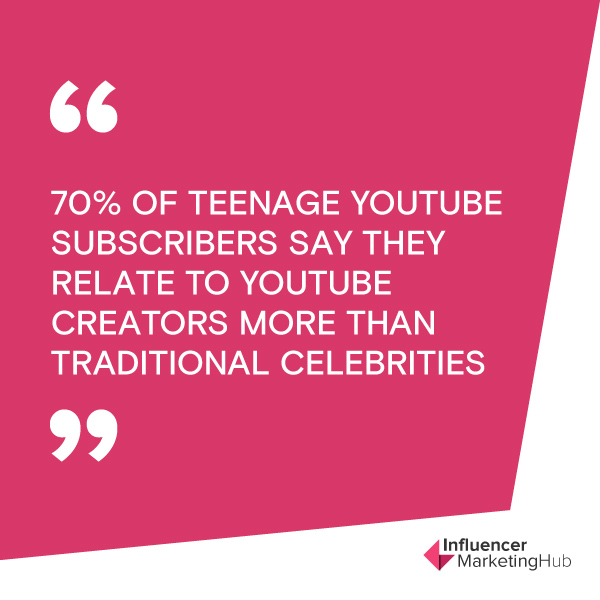
-
6 in 10 YouTube subscribers would follow advice on what to buy from their favorite creator over their favorite TV or movie personality
This is another sobering statistic from Google that emphasizes the differences between the generations. If marketers do not recognize these marked differences, they do so at their peril.
-
Firms still find it difficult to determine the Return on Investment on an Influencer Marketing Campaign
As influencer marketing has become more widespread, there have been quite a few studies on how to best determine an ROI from a campaign. The reality is that the ROI is very much determined by the brand’s intention. Traditional marketers and executives still struggle with this open-ended concept.
-
Quote: “It’s really hard to measure true influence.”
Duane Forrester, VP of Organic Search Operations at Bruce Clay, emphasizes how difficult it is to come up with the definitive measure of influence. He does, however, recognize that although this metric may be difficult to measure it is still nonetheless exceedingly important.
-
When looking for influencers, it is important to engage people who already have an affinity for your brands.
If people already love your products, they will speak about them with passion and knowledge, and this will, in turn, inspire others
-
88% of consumers say they trust online reviews as much as personal recommendations
This is a finding from the BrightLocal Local Consumer Review Survey 2014. It does emphasize the high level of influence influencers can have on their audience. It is, of course, another reason why influencers try to be authentic with their following – they don’t want to lose face.
-
72% of consumers will take some action after reading a positive review
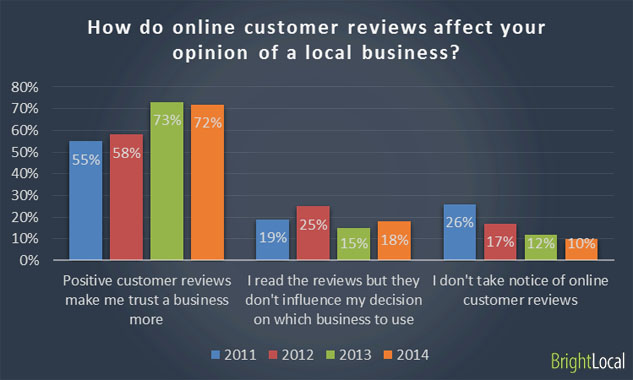
How do online customer reviews affect your opinion of a local business? Source: BrightLocal
This is further a reason from the BrightLocal survey why firms need to work on ensuring that they receive positive online reviews for their products.
-
150 million people use Snapchat daily, making it a highly viable influencer marketing channel
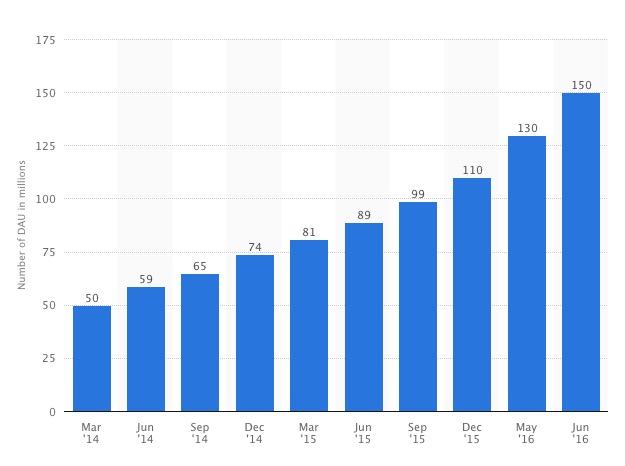
Daily active users on Snapchat. Source: Statista
Snapchat has quickly grown to 150 million users, and it is particularly popular with teenagers. Brands who target this demographic are finding that it has huge potential for influencer marketing
-
The best influencer marketing campaigns are very organic and do not look like advertising.
They seem to work best when brands engage influencers to tell a story on behalf of the brands in intuitive ways.
-
Ad-blocking is running at between 10% (Japan) and 38% (Poland), but much higher amongst under-35s
This is a finding in the Reuters Institute Digital News Report 2016. It emphasizes how poorly traditional ads are likely to perform, particularly for the young, if online users do not even view them.
-
More than a quarter of 18–24s say social media (28%) are their main source of news – more than television (24%) for the first time.
Another finding from the Reuters Institute Digital News Report that emphasizes how much more important social media is for the younger generations than television. However, many marketers still spend a fortune on television advertising and are still reluctant to market online.
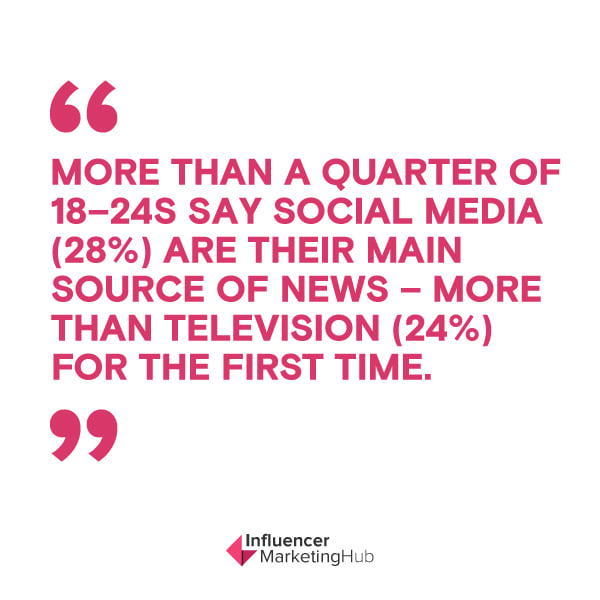
-
Quote: “Social media allows big companies to act small again.”
Jay Baer has regular social media speaking engagements. This is one of his regular one-liners he likes to use regularly – and it is of course very true when it comes to influencer marketing.
-
Quote: “Social media changes the relationship between companies and customers from master and servant, to peer to peer.”
Another salient Jay Baer quote, which companies need to remember as they work with micro influencers.
-
Influence can be fickle. It can change almost overnight.
The list of influential people on social media is constantly changing. Today’s influencer may be tomorrow’s has-been. It is important that brands keep up-to-date with who the current influencers are. Even Pewdiepie will seem old one day.
-
Some brands are influencers already
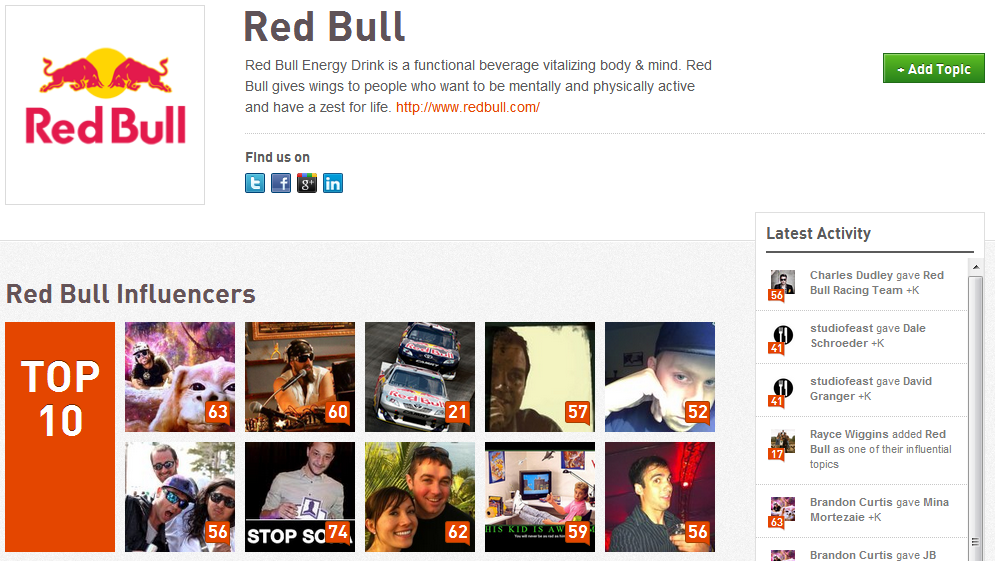
Top Red Bull influencers on Klout
Some brands have established sufficient online clout that they can be considered influencers themselves. Red Bull, for instance, has established a very active YouTube presence and currently has 5.6 million subscribers to their main channel and they have numerous smaller specialist channels, too.
-
68% of bloggers prefer to work directly with a brand instead of an agency or network
4,000 were surveyed by Grouphigh. One thing that came through is that although more agencies pitched bloggers than brands did, bloggers preferred to work directly with brands.
-
Half of Internet users never click on online ads while 35% click on less than five ads a month
This is a result of a poll taken by Infolinks. Clearly, people now suffer from “banner blindness” and this in one of the reasons why influencer marketing has grown as a more feasible alternative.
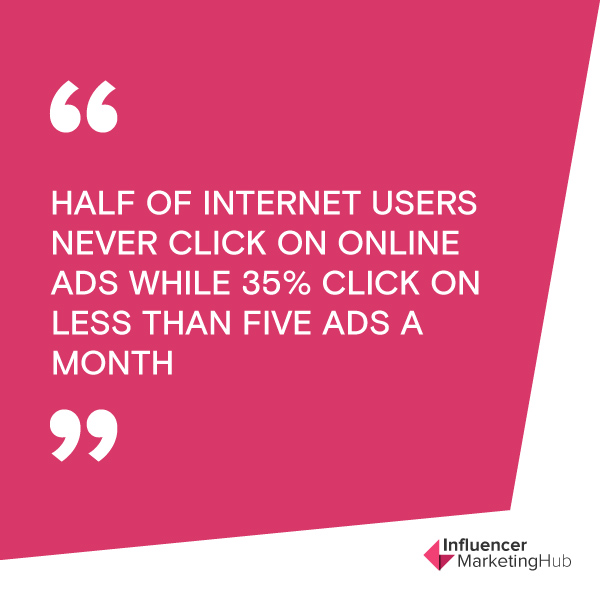
-
Quote: “ People want to do business with you because you help them get what they want. They don’t do business with you to help you get what you want.”
Don Crowther reminds businesses of the real reason that firms receive customers. Even influencers won’t help your sales if you can’t provide what consumers truly want.
-
Quote: “Influencers are people with significant networks (followers, readers, etc.) who can speak to a broad range of products and services with the ability to sway opinions in their favor.”
Digital strategist, blogger, and influencer, Jess Estrada, gives her opinion on what makes an influencer
-
Social Networks Influence 74% of Consumers’ Buying Decisions
According to a study by digital marketing agency ODM Group, 74% of consumers rely on social networks to guide their purchase decisions.
-
Quote: “Influencers think that because they have some audience, they have the power. And of course they have some power, but they should be careful in how they use it.”
Tim Bax of iCrossing issuing a warning to those influencers who risk alienating the brands who pay them.
-
Lord & Taylor Got 50 Instagrammers to Wear the Same Dress, Which Promptly Sold Out
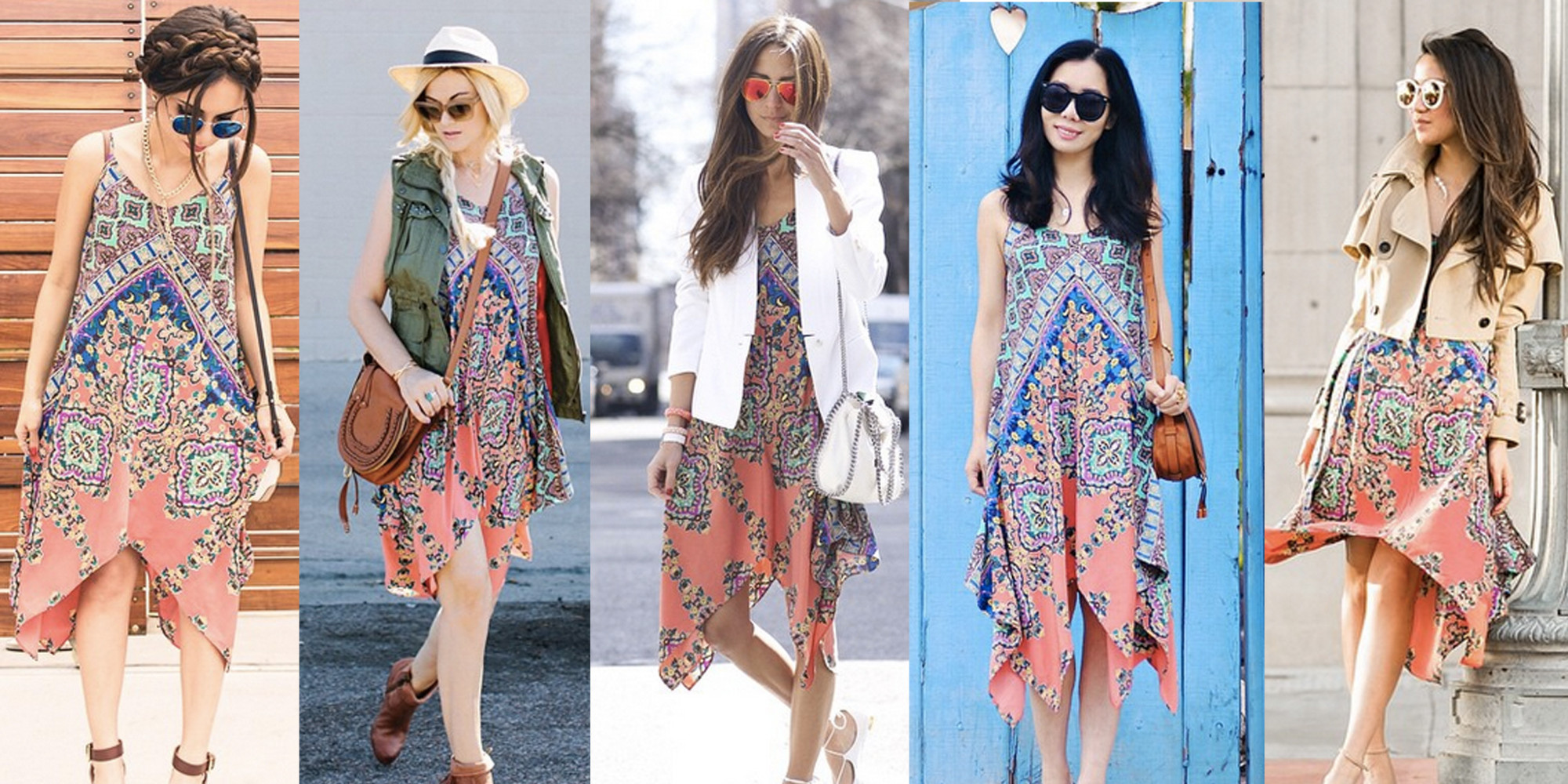
5 fashion bloggers that collaborated with Lord & Taylor
Retailer Lord & Taylor partnered with 50 influential fashionistas on Instagram and had each pose wearing the same dress. The dress sold out by the end of the weekend, and it gave the brand a chance to introduce their Design Lab Collection to potential customers, who followed these influencers.
-
84% of companies plan on working with a social media star in the next year
This was according to a survey conducted by Augure and reported in Mediakix. Collaborating with a digital influencer is now one of the most trusted and effective ways for brands to reach consumers.
-
Instagram has 300 million monthly users, almost half of whom are between the ages of 16 and 24
This provides a huge potential audience for brands that focus on youth and can benefit from Instagram’s visual strengths.

-
As an Instagram influencer’s follower total rises, the rate of engagement (likes and comments) with followers decreases
This is the key finding from a survey carried out by Markerley. Those with less than 1,000 followers generally received likes on their posts 8% of the time. Users with 10 million+ followers only received likes 1.6% of the time.
-
Influencers in the 10k-100k follower range offer the best combination of engagement and broad reach
As a result of their research, Markerly believes that influencers in the 10k-100k follower range are the micro influencers that brands should focus their influencer marketing on – not celebrities with huge followings but low engagement.
-
Quote: “Our research shows that real life influencers who are passionate about what they are recommending have significantly more buying conversations, and consumers are more likely to act on their recommendations.”
Brad Fay, co-founder, COO and lead researcher of the Keller Fay Group, commenting on research that his group carried out on the scope of micro-influencers.
-
Micro-influencers have 22.2 times more conversations weekly about recommendations on what to buy when compared to an average consumer
This was a key result that came out of the above research carried out by The Keller Fay Group and Expercity.
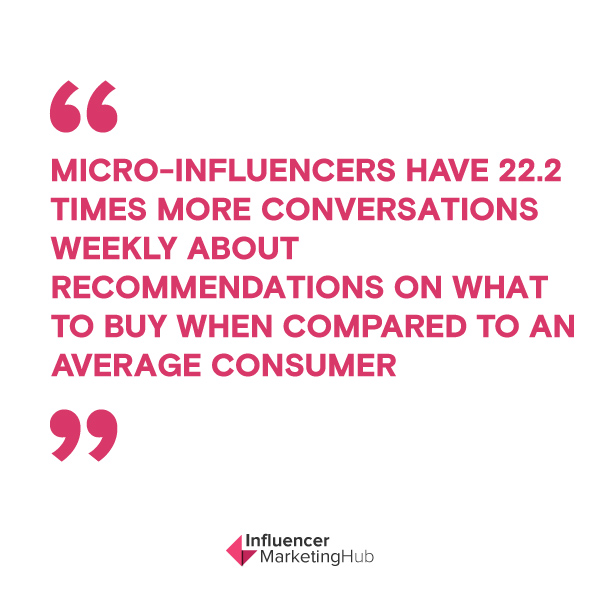
-
64% of brands are now on Snapchat
Snapchat’s brand adoption rate grew 50% from January to October last year, with 64% of brands now on the app, according to L2’s fourth annual intelligence report on social platforms asreported on Marketing DIVE. L2 also noted that social media ad spending is growing faster than any other investment channel.


